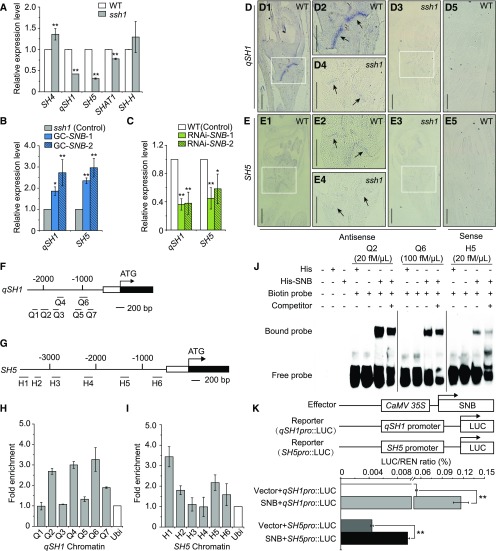Figure 6.
SNB Positively Regulates the Expression of qSH1 and SH5.
(A) Comparison of the expression levels of five rice seed shattering genes in 0- to 4-cm young panicles of the wild type and the ssh1 mutant. The rice housekeeping gene UBIQUITIN was used as an internal control to normalize gene expression data. Values are means ± sd (n = 3 pooled tissues, five plants per pool). Two-tailed Student’s t tests were used to compare the wild type and the ssh1 mutant (**, P < 0.01).
(B) Comparison of expression levels of qSH1 and SH5 in the young panicles (0–4 cm) of the GC-SNB lines and the ssh1 mutant (control).
(C) Comparison of the expression levels of qSH1 and SH5 in the young panicles (0–4 cm) of the RNAi-SNB plants and the wild type (control).
In (B) and (C), the rice housekeeping gene UBIQUITIN was used as an internal control to normalize gene expression data. Values are means ± sd (n = 3 pooled tissues, five plants per pool). Two-tailed Student’s t tests were used to compare the transgenic lines and the corresponding controls (*, P < 0.05 and **, P < 0.01; Supplemental File 2).
(D) and (E) Stronger mRNA hybridization signals of qSH1 (D) and SH5 (E) are detected in the AZ of the wild type than the ssh1 mutant. (D2), (D4), (E2), and (E4) are magnifications of the white boxes in (D1), (D3), (E1), and (E3), respectively, and the arrows indicate the abscission layer. (D5) and (E5) show the hybridization signal using the sense probes as a negative control. Bars = 200 μm.
(F) to (I) ChIP-qPCR assays of qSH1 and SH5 using ChIP-DNA complexes isolated from 0- to 4-cm young panicles of the SNB-GFP transgenic plants. (F) and (G) show the genomic structures of qSH1 and SH5, respectively. The numbers (Q1 to Q7 and H1 to H6) indicate the tested regions. (H) and (I) show the enrichment of SNB on the qSH1 and SH5 chromatin, indicated as the fold change in the immunoprecipitation sample over the control containing no antibodies. Values are means ± sd (n = 3 pooled tissues, 10 plants per pool).
(J) EMSA revealed that the His-SNB recombinant protein was able to bind to both the Q2 and Q6 fragments of the qSH1 promoter and the H5 fragment of the SH5 promoter.
(K) Dual luciferase reporter assays in rice protoplasts showed that the SNB protein promoted the expression of the LUC gene through binding to the qSH1 and SH5 promoters. Vector represents the pGreenII 62-SK empty vector, and REN represents the Renilla luciferase gene. Values are means ± sd (n = 3 biological replicates). Difference significance analysis was conducted with two-tailed Student’s t tests (**, P < 0.01; Supplemental File 2).

